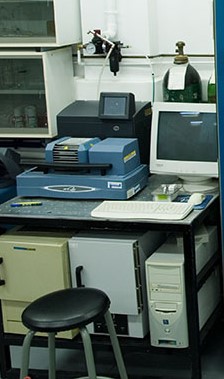Simultaneous Thermogravimetric Analysis (TGA) and Differential Scanning Calorimetry (DSC) based on a computer-controlled SDT Q600 TA-instruments apparatus.
Applications:
SDT Q600, is an analysis system capable of performing DSC and TGA at the same time, and as such it removes experimental and sampling variables in data analysis. The information provided differentiates endothermic and exothermic events, which have no associated weight change (e.g. melting and crystallization or even long-range magnetic order) from those which involve a weight change (e.g. degradation).
Specifications:
The SDT measures the heat flow and weight changes associated with transitions and reactions in materials, from ambient temperature and up to 1500°C. The system entails a physical property sensor (cf. thermocouple, balance), a controlled atmosphere (e.g. noble gas, O2/air) furnace and a temperature programmer, all interfaced to a computer, allowing for a bi-modal operation, namely:
TGA characterizes any material that exhibits weight loss or phase changes as a result of decomposition, dehydration, and oxidation. Two modes are commonly used for investigating thermal stability behavior in controlled atmospheres: (a) dynamic, in which the temperature is increased at a linear rate, and (b) isothermal, in which the temperature is kept constant.
DSC is acomplissed by employing a single heat source and two symmetrically located and identical sample platforms at the end of two parallel beams. Thermocouples, welded at the center of the sample platforms, measure the differential heat flow to the sample and reference as both are heated at a uniform rate by the furnace. Sample temperature is also monitored directly by the thermocouple in the sample platform. With proper calibration, the heat flow associated with endothermic and exothermic transitions in materials can be measured to a high degree of accuracy and precision (+ 2%). Without calibration, the heat flow results obtained are qualitative (DTA).
Sample-containing cup sizes
- alumina ceramic 40 µL, 90 µL (recommended for DSC-TGA studies)
- platinum 40 µL, 110 µL (recommended for TGA-DTA studies)

